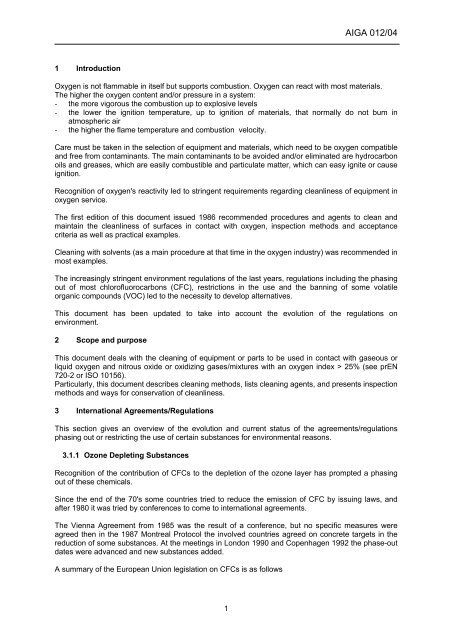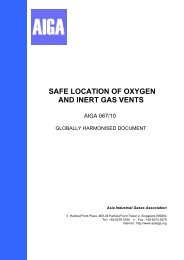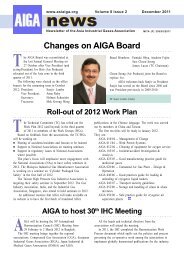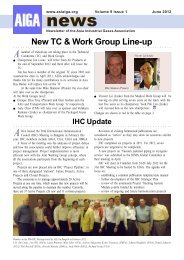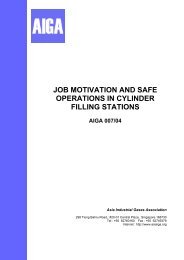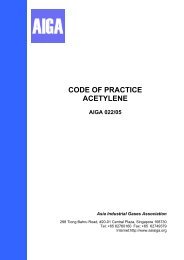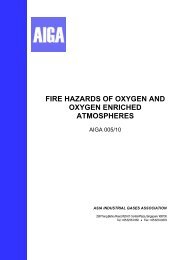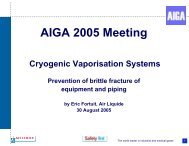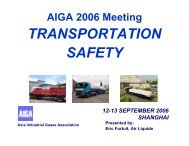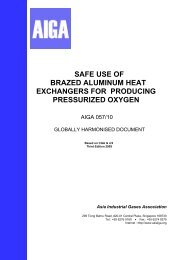CLEANING OF EQUIPMENT FOR OXYGEN SERVICE - AIGA
CLEANING OF EQUIPMENT FOR OXYGEN SERVICE - AIGA
CLEANING OF EQUIPMENT FOR OXYGEN SERVICE - AIGA
You also want an ePaper? Increase the reach of your titles
YUMPU automatically turns print PDFs into web optimized ePapers that Google loves.
1 Introduction<br />
1<br />
<strong>AIGA</strong> 012/04<br />
Oxygen is not flammable in itself but supports combustion. Oxygen can react with most materials.<br />
The higher the oxygen content and/or pressure in a system:<br />
- the more vigorous the combustion up to explosive levels<br />
- the lower the ignition temperature, up to ignition of materials, that normally do not bum in<br />
atmospheric air<br />
- the higher the flame temperature and combustion velocity.<br />
Care must be taken in the selection of equipment and materials, which need to be oxygen compatible<br />
and free from contaminants. The main contaminants to be avoided and/or eliminated are hydrocarbon<br />
oils and greases, which are easily combustible and particulate matter, which can easy ignite or cause<br />
ignition.<br />
Recognition of oxygen's reactivity led to stringent requirements regarding cleanliness of equipment in<br />
oxygen service.<br />
The first edition of this document issued 1986 recommended procedures and agents to clean and<br />
maintain the cleanliness of surfaces in contact with oxygen, inspection methods and acceptance<br />
criteria as well as practical examples.<br />
Cleaning with solvents (as a main procedure at that time in the oxygen industry) was recommended in<br />
most examples.<br />
The increasingly stringent environment regulations of the last years, regulations including the phasing<br />
out of most chlorofluorocarbons (CFC), restrictions in the use and the banning of some volatile<br />
organic compounds (VOC) led to the necessity to develop alternatives.<br />
This document has been updated to take into account the evolution of the regulations on<br />
environment.<br />
2 Scope and purpose<br />
This document deals with the cleaning of equipment or parts to be used in contact with gaseous or<br />
liquid oxygen and nitrous oxide or oxidizing gases/mixtures with an oxygen index > 25% (see prEN<br />
720-2 or ISO 10156).<br />
Particularly, this document describes cleaning methods, lists cleaning agents, and presents inspection<br />
methods and ways for conservation of cleanliness.<br />
3 International Agreements/Regulations<br />
This section gives an overview of the evolution and current status of the agreements/regulations<br />
phasing out or restricting the use of certain substances for environmental reasons.<br />
3.1.1 Ozone Depleting Substances<br />
Recognition of the contribution of CFCs to the depletion of the ozone layer has prompted a phasing<br />
out of these chemicals.<br />
Since the end of the 70's some countries tried to reduce the emission of CFC by issuing laws, and<br />
after 1980 it was tried by conferences to come to international agreements.<br />
The Vienna Agreement from 1985 was the result of a conference, but no specific measures were<br />
agreed then in the 1987 Montreal Protocol the involved countries agreed on concrete targets in the<br />
reduction of some substances. At the meetings in London 1990 and Copenhagen 1992 the phase-out<br />
dates were advanced and new substances added.<br />
A summary of the European Union legislation on CFCs is as follows


